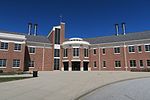Wauregan, Connecticut

Wauregan is a village located in the northwestern corner of the town of Plainfield, Connecticut in the United States. Originally a mill village, Wauregan was established around a cotton mill powered by the Quinebaug River. Wauregan and West Wauregan, across the Quinebaug in the town of Brooklyn, together comprise the Wauregan census-designated place, with a population of 1,205 at the 2010 census.A 90-acre (360,000 m2) portion of the original village area is listed as a historic district, the Wauregan Historic District, encompassing structures that are directly related to the economic and social activities of the mill. The district was listed on the National Register of Historic Places in 1979. Extant buildings in the Wauregan historic district include the Wauregan Mill, an H-shaped building built from local fieldstone; James Atwood's home; the two boarding houses; the company store; and over one hundred workers' houses. Architectural styles represented include Greek Revival and Late Victorian architecture.
Excerpt from the Wikipedia article Wauregan, Connecticut (License: CC BY-SA 3.0, Authors, Images).Wauregan, Connecticut
Front Street,
Geographical coordinates (GPS) Address Nearby Places Show on map
Geographical coordinates (GPS)
| Latitude | Longitude |
|---|---|
| N 41.743888888889 ° | E -71.910555555556 ° |
Address
Front Street 8
06374
Connecticut, United States
Open on Google Maps








